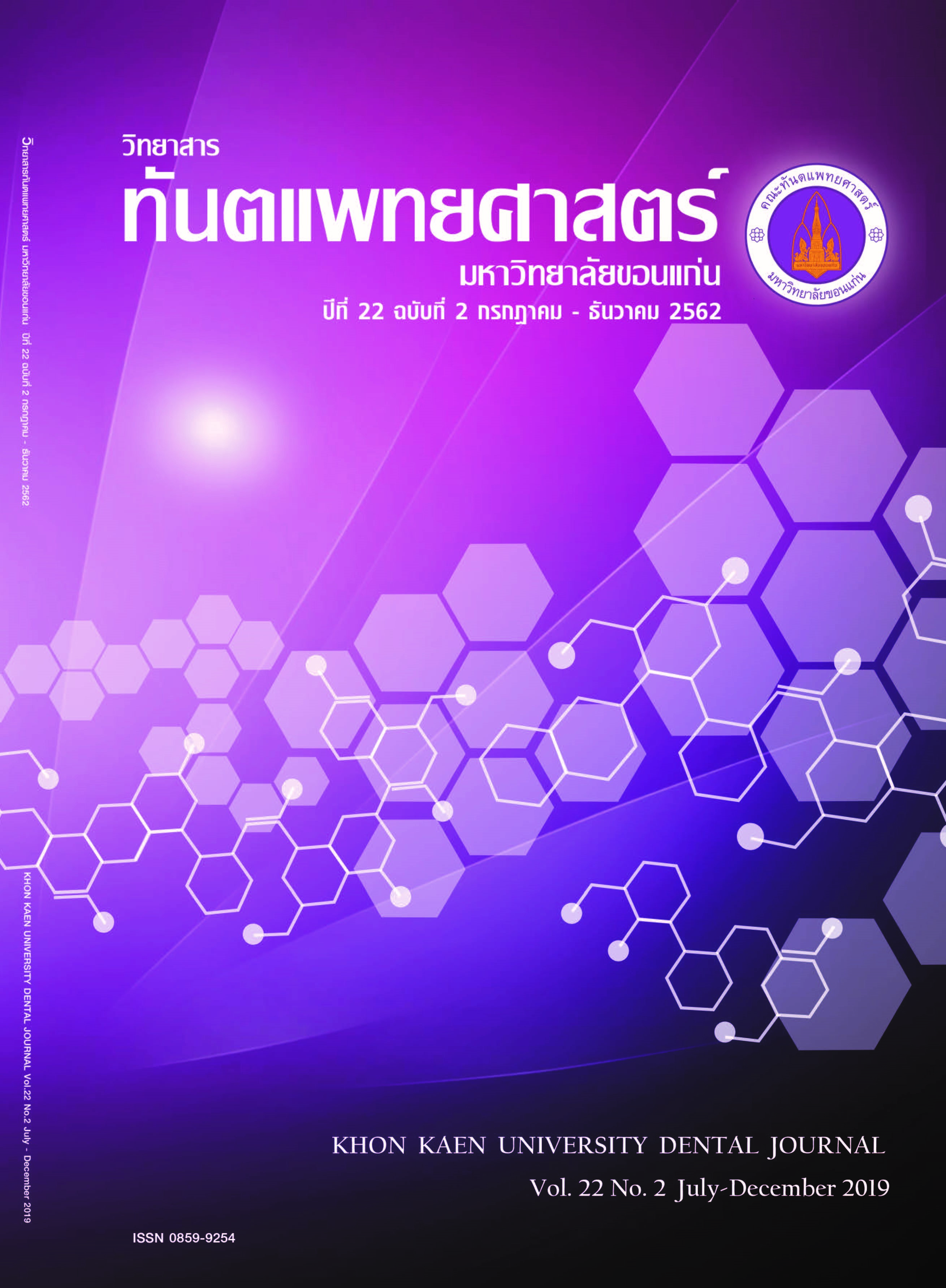Analysis of the Contraction Stresses During the Polymerization Shrinkage of Bulk-fill Resin Composites and Nanocomposite by Finite Element Method
Main Article Content
Abstract
This study aimed to analyze stress values in three dimensional (3D) solid model of mandibular first molar restored with four bulk-fill resin composite materials and one nanocomposite material using finite element method .A 3D solid model of mandibular first molar was designed using micro-CT data and SolidWorks software. Class II mesio-occluso-distal (MOD) cavity design was simulated. Four bulk-fill resin composites are Filtek™ Bulkfill Posterior Restorative) FBF), X-tra fil® (XF), SonicFill ) FS) and Tetric® N Ceram Bulk fill (TNB). For all 4 bulk-fill resin composites, the cavities were simulated to fill up with bulk technique. For one nanocomposite is Filtek™Z350XT (Z350). The cavity was simulated to fill up with 2 horizontal layers (2mm each) incremental technique. Polymerization shrinkage of resin composite materials were simulated by thermal analogy. Von-Mises stress in cavity, Maximum principal stress in adhesive layer and safety factor in adhesive layer were analyzed by descriptive statistics .This study found that cavities restored with bulk fill resin composites had Von-Mises stress and Maximum principal stress in adhesive layer higher than nanocomposite. Safety factor showed no debonding area in adhesive layer.
Article Details
บทความ ข้อมูล เนื้อหา รูปภาพ ฯลฯ ที่ได้รับการลงตีพิมพ์ในวิทยาสารทันตแพทยศาสตร์ มหาวิทยาลัยขอนแก่นถือเป็นลิขสิทธิ์เฉพาะของคณะทันตแพทยศาสตร์ มหาวิทยาลัยขอนแก่น หากบุคคลหรือหน่วยงานใดต้องการนำทั้งหมดหรือส่วนหนึ่งส่วนใดไปเผยแพร่ต่อหรือเพื่อกระทำการใด ๆ จะต้องได้รับอนุญาตเป็นลายลักษณ์อักษร จากคณะทันตแพทยศาสตร์ มหาวิทยาลัยขอนแก่นก่อนเท่านั้น
References
Ferracane JL. Resin composite--state of the art. Dent Mater 2011;27(1):29-38.
Campos EA, Ardu S, Lefever D, Jasse FF, Bortolotto T, Krejci I. Marginal adaptation of class II cavities restored with bulk-fill composites. J Dent 2014;42(5):575-81.
Taha NA, Palamara JE, Messer HH. Cuspal deflection, strain and microleakage of endodontically treated premolar teeth restored with direct resin composites. J Dent 2009;37 (9):724-30.
Hilton TJ. Can modern restorative procedures and materials reliably seal cavities? In vitro investigations. Part 1. J Am Dent Assoc 2002;15(4):198-210.
Watts DC, Marouf AS, Al-Hindi AM. Photo-polymerization shrinkage-stress kinetics in resin-composites: methods development. Dent Mater 2003;19(1):1-11.
Kinomoto Y, Torii M, Takeshige F, Ebisu S. Comparison of polymerization contraction stresses between self and light curing composites. J Dent 1999;27(5):383-9.
Park JW, Ferracane JL. Measuring the residual stress in dental composites using a ring slitting method. Dent Mater 2005;21(9):882-9.
Magne P. Efficient 3D finite element analysis of dental restorative procedures using micro-CT data. Dent Mater 2007;23(5):539-48.
Ausiello P, Apicella A, Davidson CL. Effect of adhesive layer properties on stress distribution in composite restorations—a 3D finite element analysis. Dent Mater 2002;18(4): 295–303.
International Standards Organization. Dentistry- Polymer-based filling, restorative and luting material. 3rd ed: ISO 4049;2000. p.15-8.
Kim ME, Park SH. Comparison of premolar cuspal deflection in bulk or in incremental composite restoration methods. Oper Dent 2011;36(3):326-34.
Chen TY, Huang PS, Chuang SF. Modeling dental composite shrinkage by digital image correlation and finite element methods. Opt Lasers Eng 2014;61:23-30.
Chuang SF, Chang CH, Chen TY. Contraction behaviors of dental composite restorations--finite element investigation with DIC validation. J Mech Behav Biomed Mater 2011;4 (8):2138-49.
Rodrigues FP, Silikas N, Watts DC, Ballester RY. Finite element analysis of bonded model Class I ‘restorations’ after shrinkage. Dent Mater 2012;28(2):123-32.
Sakchuchawan C, Sukjit K, Pasasuk A, Puasiri S. In Vitro Comparison of volumetric polymerization shrinkage and microleakage of bulk fill resin based composites [Unpublished master’s thesis]: Department of Restorative Dentistry, Faculty of Dentistry, Khon Kaen University; 2015.
Sangwichit K, Kingkaew R, Pongprueksa P, Senawongse P. Effect of thermocycling on the durability of etch-and-rinse and self-etch adhesives on dentin. Dent Mater J 2016; 35(3):360-8.
Lee SY, Park SH. Correlation Between the Amount of Linear Polymerization Shrinkage and Cuspal Deflection. Oper Dent 2006;31(3):364-70.
Goel VK, Khera SC, Ralston JL, Chang KH. Stresses at the dentin enamel junction of human teeth--a finite element investigation. J Prosthet Dent 1991;66(4):451-9.
Haak R, Wicht MJ, Noack MJ. Marginal and internal adaptation of extended class I restorations lined with flowable composites. J Dent 2003;31(4):231-9.
Dejak B, Mlotkowski A. A comparison of stresses in molar teeth restored with inlays and direct restorations, including polymerization shrinkage of composite resin and tooth loading during mastication. Dent Mater 2015;31(3):e77-87.
Toparli M, Aksoy T. Fracture toughness determination of composite resin and dentin/composite resin adhesive interfaces by laboratory testing and finite element models. Dent Mater 1998;14(4):287-93.


